|

 Up
Up 
 Model EX
Model EX 
(You are here.)



  Need
to Need
to
find your
bearings?
Try
these
navigation aids:
If
this is your first
visit, please stop by:
Something
to share?
Please:



|
|
Available in Française, Español, Português, Deutsch, Россию,
中文,
日本, and others.
 he
"EX" stood for "exhibition." This was a small, fast,
single-seat airplane the Wright built for exhibition flying. Although it's
often said the Model EX was a single-seat Model B, this is not true. The
airframe was derived from the 1910 Model R "Baby
Wright." In that aircraft, the Wrights had reduced the gap
between the wings, substantially reducing the amount of rigging
wire. This, in turn, reduced drag and allowed the Baby Wright to
reach speeds of up to 55 miles per hour with just a 30 hp engine.
For the EX, the Wrights increased the chord and lengthened the wings
to give it more lift and better control. Changes in the landing gear
further reduced drag, and with improvements in the engine and drive
train the Wright Company kept the top speed at 55 mph (89 kph). he
"EX" stood for "exhibition." This was a small, fast,
single-seat airplane the Wright built for exhibition flying. Although it's
often said the Model EX was a single-seat Model B, this is not true. The
airframe was derived from the 1910 Model R "Baby
Wright." In that aircraft, the Wrights had reduced the gap
between the wings, substantially reducing the amount of rigging
wire. This, in turn, reduced drag and allowed the Baby Wright to
reach speeds of up to 55 miles per hour with just a 30 hp engine.
For the EX, the Wrights increased the chord and lengthened the wings
to give it more lift and better control. Changes in the landing gear
further reduced drag, and with improvements in the engine and drive
train the Wright Company kept the top speed at 55 mph (89 kph).
Wright Model EX specifications:
- 31.5 ft (11.9 m) wingspan
- 5 ft (152 cm) chord
- 3.5 ft (107 cm) separation
- 310 sq ft (28.8sq. m) wing area
- 1:20 camber
- 30
sq ft (2.8 sq m) horizontal rear elevator
- 10.2 sq ft (0.9 sq m) twin movable vertical rear rudders
- 21.5 ft (6.5 m) overall length
- 735 lbs (333 kg) total weight (without pilot or passenger)
- 4 cylinder engine, 35 hp (approx.) running at 1500 rpm
- Two contra-rotating propellers, 8.5 ft (259 cm) long, turning
at 450 to 470 rpm
- 55 mph (89 kph) average speed
The Wrights built a special Model EX, called the
Vin Fiz,
for Cal Rodgers.
This was the first airplane to fly across
America.
Sponsored by Armour Meats to advertise a grape-flavored soft drink called Vin Fiz, Cal
Rodgers started on 17 Sep 1911 at Sheepshead Bay on Long Island, NY, landed
in Pasadena, CA on 5 Nov 1911. Later Rogers flew on to Long Beach. The Vin
Fiz was flown in exhibition flights until 1914, then it's history
becomes murky. Sometime on or after 1917, a Vin Fiz turned up
at the Carnegie Museum in Pittsburg, PA, but whether this was the
original or a clone made from some of the many parts that were
removed and replaced during its cross-country flight is hard to say.
Whatever its history, the aircraft was transferred to the
Smithsonian in 1934 and completely rebuilt in 1960.
References:
- McFarland
- E.P. Stein, "The Flight of the Vin Fiz," Arbor House, New
York, 1985, pp. 347
[Submitted by Joe W. McDaniel] |
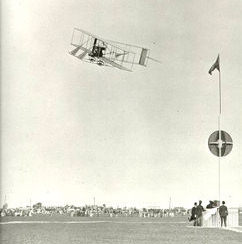
A Wright Model EX rounds a pylon at an air race. Because they were
faster than most aircraft of the day, they were sometimes used for
racing.
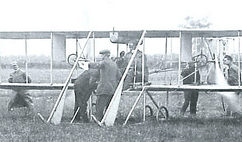
A Model EX is readied for take-off.

The most famous Model EX was the
Vin Fiz, in which Cal Rodgers made the first transcontinental
flight.
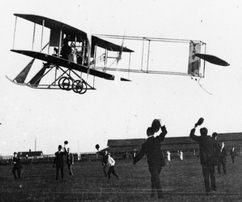
The Vin Fiz takes off from
Sheepshead Bay, Long Island, New York on 17 September 1911.
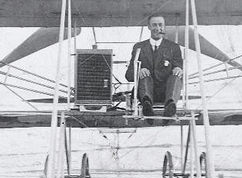
Rodgers wets the landing gear of the
Vin Fiz in the Pacific Ocean
after arriving at Long Beach, California on 10 December 1911.
|
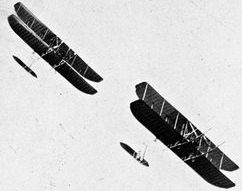
A Wright Model B (right) and the Wright Model EX (left) flying side
by side at the St. Louis fair in 1912.
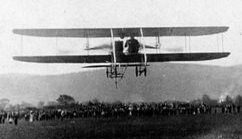
And takes off. Because they were light, the EX could climb faster
than the B.
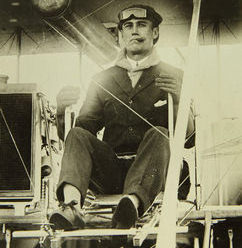
Cal Rodgers in the cockpit of the
Vin Fiz.
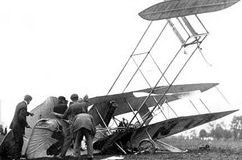
While crossing America, Cal Rodgers survived five major crashes
after which the Vin Fiz had
to be rebuilt.
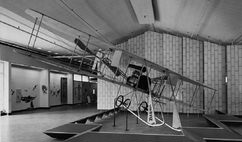
The Vin Fiz – or a clone of
the Vin Fiz – at the
Smithsonian shortly after it was restored in 1960.
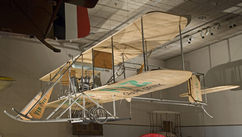
The Vin Fiz as it appears
today.
|